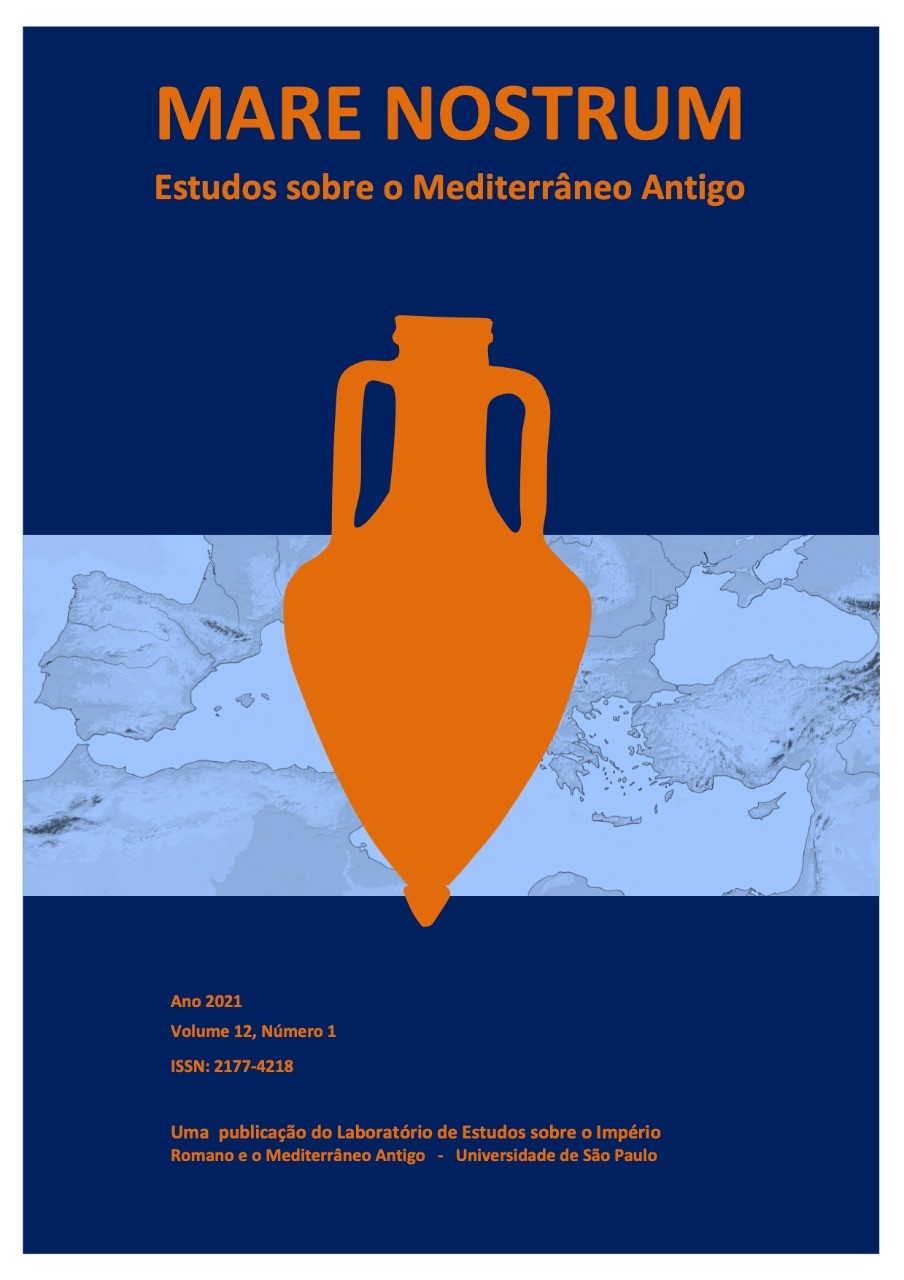Arqueologia de uma Procissão Antiga: a Prática da πομπή entre Atenas e Elêusis no Período Romano (II - III d.C.)
DOI:
https://doi.org/10.11606/issn.2177-4218.v12i1p111-137Palavras-chave:
Mistérios de Elêusis, Procissão antiga, Grécia romana, Elêusis, Eleusinion de Atenas, Religião grega antigaResumo
O presente artigo tem como objetivo identificar as particularidades da procissão celebrada entre Atenas e Elêusis durante os Mistérios Eleusinos no Período Romano (Séc. II - III d.C.) a partir de evidências constatadas em fontes de diferentes naturezas (textual, topográfica/arquitetônica e epigráfica). Procura-se compreender os aspectos relativos à permanência da tradição ancestral eleusina e identificar inovações próprias dos estratos históricos romanos, cujas evidências podem ser observadas tanto na organização da procissão quanto nas intervenções construtivas dos santuários (Elêusis e o Eleusinion de Atenas) e da via sacra (hierá hodós).
Downloads
Referências
Fontes
Pausanias. (1992). Description of Greece (Books 1-2). Harvard University Press.
Obras
Agelidis, S. (2017). The ‘Spatial Turn’ in Ancient Greek Festival Research: Venues of the Athenian City Dionysia and the Great Panathenaia Pompai. In L. Nevett (Org.). Theoretical Approaches to the Archaeology of Ancient Greece: Manipulating Material Culture (pp. 230-248). University of Chicago Press.
Alcock, S. E. (2002). Archaeologies of the Greek Past: Landscapes, Monuments, and Memories. Cambridge University Press.
Baldassarri, P. (2007). Copia architettonica come memoria del passato. I Grandi Propilei di Eleusi i il santuario eleusino eleusino in età antonina. In O. D. Cordovana, & M. Galli (Eds.). Arte e memoria culturale nell’età della Seconda Sofistica (pp. 211-233). Edizioni del Prisma.
Barnard, B. E. (2011). Euergetism and Gift-Giving at Eleusis: a case study of Ancient Patronage Structures. [Dissertação de mestrado não publicada]. University of Nebraska-Lincoln.
Best, J. (2015). Religion of the Roadaways: Roadside Sacred Spaces in Attica. [Tese de doutorado não publicada]. Bryn Mawr College.
Camia, F. (2017). Cultic and Social Dynamics in the Eleusinian Sanctuary under the Empire. In E. M. Grijalvo, & J. M. C. Copete, & F. L. Gómez (ed.). Empire and Religion: Religious change in Greek cities under Roman Rule (pp. 45-66). Brill.
Clinton, K. (1993). The sanctuary of Demeter and Kore at Eleusis. In B. Marinatos, & R. Hägg. Greek sanctuaries: new approaches (pp. 110-124). Routledge.
Clinton, K. (2005). Eleusis. The Inscriptions on Stone: Documents of the Sanctuary of the two Goddesses and public documents of the deme (Vol. I: Text). The Archaeological Society of Athens.
Clinton, K. (2008) Eleusis. The Inscriptions on Stone: Documents of the Sanctuary of the two Goddesses and public documents of the deme (Vol. II: Commentary). The Archaeological Society of Athens.
Clinton, K. (2019). Journeys to the Eleusinian Mysteria (with an appendix on the procession at the Andanian Mysteria). In W. Friese, S. Handberg, & T. M. Kristensen (Ed.). Ascending and descending the Acropolis: Movement in Athenian Religion (Monographs of the Danish Institute at Athens, 23) (pp. 161-177). Aarhus University Press.
Cosmopoulos, M. B. (2015). Bronze Age Eleusis and the Origins of the Eleusinian Mysteries. Cambridge University Press.
Drakotou, I. (2009). Ιερά Οδός, ανατολικό τμήα. Ιn M. Korres. Αττικής Οδού. Αρχαιου Δρομου τής Αττικής. Εκδότης ΜΕΛΙΣΣΑ.
Elsner, J. (2001). Structuring ‘Greece’: Pausanias’ Periegesis as a Literary Construct. In S. E. Alcock, J. F. Cherry & J. Elsner (Eds.). Pausanias: Travel and Memory in Roman Greece (pp. 3-20). Oxford University Press.
Ficuciello, L. (2008). Le Strade di Atene (SATAA, 4). Scuola Archeologica Italiana di Atene. Pandemos.
Graf, F. (1996). Pompai in Greece: Some consideration about Space and Ritual in the Greek polis. In R. Hägg (Ed.). The role of Religion in the Early Greek Polis: Proceedings of the Third International Symposium on Ancient Greek Cult (pp. 55-65). Svenska Institutet i Athen.
Hazard, S. (2013). The Material Turn in the Study of Religion. Religion and Society: Advances in Research, 4, 58-78.
Knott, K. (2008). Spatial Theory and the Study of Religion. Religion Compass, 2(6), 1102-1116.
Lambert, S. (2020). Attic Inscriptions in UK Collections British Museum: Decrees of the Council and Assembly (AIUK, 4.2). British Museum.
Lenormant, F. (1860). Monographie de la voie sacrée éleusinienne et des ses monuments et ses souvenirs. Hachette.
Le Roy, J. (2004). The Ruins of the Most Beautiful Monuments of Greece. Getty Publications. (Trabalho original publicado em 1755)
Lippolis, E. (2006). Mysteria: Archeologia e culto del santuario di Demetra ad Eleusi. Bruno Mondadori.
Luginbühl, T. (2015). Ritual Activities, Processions and Pilgrimages. In R. Raja, & J. Rüpke. A Companion to the Archaeology of Religion in the Ancient World (pp. 41-59). John Wiley & Blackwell.
Miles, M. (2012). Entering Demeter’s Gateaway: The Roman Propylon in the City Eleusinion. In B. Wescoat, & R. Ousterhout. Architecture of the Sacred Space, Ritual, and Experience from Classical Greece to Byzantium (pp. 114-151). Cambridge.
Miles, M. (1998). The City Eleusinion: Results of Excavations conducted by The American School of Classical Studies at Athens (The Athenian Agora, 31). Princeton University PresS.
Mylonas, G. E. (2009). Eleusis and the Eleusinian Mysteries. Princeton University Press. (Trabalho original publicado em 1961)
Oliver, J. H. (1941). Documents concerning the Emperor Hadrian. Hesperia: The Journal of the American School of Classical Studies at Athens, 10(4), 361-370.
Palagia, O. (2007). The Date and the Iconography of the Calendar Frieze on the Little Metropolis, Athens. X Colloque International sur L’art Provincial Romain. Arles, FRA.
Palinkas, J. L. (2008). Eleusinian Gateaways: Entrances to the Sanctuary of Demeter and Kore at Eleusis and the City Eleusinion in Athens. [Dissertação de doutorado não publicada]. Faculty of the Graduate School of Emory University.
Papangeli, K, & Chlepa, E. A. (2011). Transformations of the Eleusinian Landscape Antiquities and the Modern City. Paul & Alexandra Canellopoulos Foundation.
Patera, I. (2011). Changes and Arrangements in a Traditional Cult: The case of the Eleusinian Rituals. In A. Chaniotis. Ritual Dynamics in the Ancient Mediterranean: Agency, Emotion, Gender, Representation (pp. 119-136). Franz Steiner-Verlag.
Perissato, F. (2018). Elêusis no Império Romano: Monumentalização do santuário e o culto dos Mistérios Eleusinos no Período Antonino. [Dissertação de mestrado não publicada]. Universidade de São Paulo.
Pretzler, M. (2007). Pausanias: Travel Writing in Ancient Greece. Bristol Classical Press.
Raja, R, & Rüpke, J. (2015). Archaeology of Religion, Material Religion, and the Ancient World. In
R. Raja, & J. Rüpke. A Companion to the Archaeology of Religion in the Ancient World (pp. 1-26). John Wiley & Blackwell.
Riccardi, L. A. (2007). The Bust-Crown, The Panhellenion, and Eleusis: a new portrait from the Athenian Agora. Hesperia: The Journal of the American School of Classical Studies at Athens, 76(2), 365-390.
Robertson, N. D. (1998). The Two Processions to Eleusis and the Program of the Mysteries. The American Journal of Philology, 119(4), 547-575.
Romeo, I. (2002). The Panhellenion and Ethnic Identity in Hadrianic Greece. Classical Philology, 97(1), 21-30.
Sauron, G. (2001). Les propylées d’Appius Claudius Pulcher à Éleusis: l’art néo-attique dans les contraditions idéologiques de la noblesse romaine à la fin de la République. In J-Y. Marc, & J-C. Moretti. Constructions publiques et programmes édilitaires en Grèce entre le IIe siècle av. J.-C. et le ler siècle ap. J.-C. Bulletin de Correspondance Hellénique, 39(Supp.), 267-283.
Shear, T. L., Jr. (2016). Trophies of Victory: Public Building in Periklean Athens. Princeton University Press.
Spawforth, A. J. S. (2012). Greece and the Augustan Cultural Revolution. Cambridge University Press. Spawforth, A. J. S., & Walker, S. (1985). The World of the Panhellenion: 1. Athens and Eleusis. The Journal of Roman Studies, 75, 78-104.
Spon, J. (1678). Voyage d’Italie, de Dalmatie, de Grèce et du Levant, fait aux années 1675-1676 (Vol. 2). Amsterdam.
Stavrianopoulou, E. (2015). The Archaeology of Processions. In R. Raja, & R; J. Rüpke. A Companion to the Archaeology of Religion in the Ancient World (pp. 349-361). John Wiley & Blackwell.
Wheler, G. (1682). A Journey into Greece in the company of Dr. Spon of Lyons. London.
Ziro, D. (1991). Ελευσις. ‘Η Κυρία Είσοδος του ιερού της Ελευσίνος. Εκδότης Εν Αθηναις Αρχαιολογικη Εταιρεια.
Downloads
Publicado
Edição
Seção
Licença
Copyright (c) 2021 Felipe Perissato

Este trabalho está licenciado sob uma licença Creative Commons Attribution 4.0 International License.
Os conteúdos expressos nos textos publicados pela Mare Nostrum são de exclusiva responsabilidade de seus respectivos autores.
A reprodução dos textos editados pela Mare Nostrum é permitida sob licença Creative Commons, Atribuição-NãoComercial (CC BY-NC).
Autores que publicam nesta revista concordam com os seguintes termos:
- Autores mantém os direitos autorais e concedem à revista o direito de primeira publicação, com o trabalho simultaneamente licenciado sob a Licença Creative Commons Attribution que permite o compartilhamento do trabalho com reconhecimento da autoria e publicação inicial nesta revista.
- Autores têm autorização para assumir contratos adicionais separadamente, para distribuição não-exclusiva da versão do trabalho publicada nesta revista (ex.: publicar em repositório institucional ou como capítulo de livro), com reconhecimento de autoria e publicação inicial nesta revista.
- Autores têm permissão e são estimulados a publicar e distribuir seu trabalho online (ex.: em repositórios institucionais ou na sua página pessoal) a qualquer ponto antes ou durante o processo editorial, já que isso pode gerar alterações produtivas, bem como aumentar o impacto e a citação do trabalho publicado (Veja O Efeito do Acesso Livre).
Como Citar
Dados de financiamento
-
Fundação de Amparo à Pesquisa do Estado de São Paulo
Números do Financiamento 2015/16650-0;2016/17061-0









